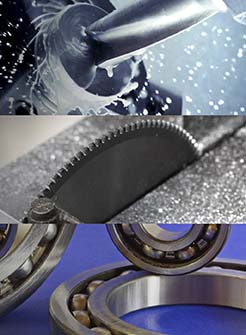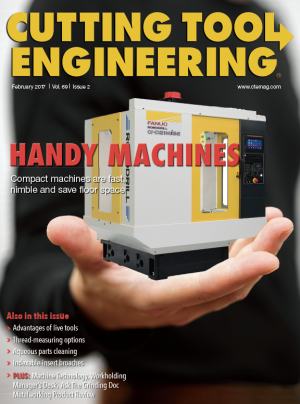A physical vapor deposition coating protects the edge of a cutting tool, for example, from the wear and tear of everyday use. However, many common industrial materials can’t take advantage of such protection because the coating process would be more damaging to them than that wear and tear. Deposition of PVD coatings commonly takes place at high temperatures—from 385° to 750° F (196° to 399° C). That has ruled out its application on some common materials, such as hardened steel.
And there’s been another limitation: The material to be coated has to be able to conduct electricity. Most PVD coating processes depend on biasing the part that’s to be coated, which means to charge it electrically and make it attract the coating molecules. That has meant that materials such as ceramics, which are able to take the heat but are nonconductive, couldn’t effectively be PVD-coated.

A PVD coating can extend the life of cutting tools,
such as drills and saws, as well as bearings. Image courtesy of SurfTech.
Now SurfTech has created a PVD coating process that can be done at temperatures as low as 200° F (93° C). This process also doesn’t depend on biasing (making it, in a sense, “free of charge”). Not only ceramics, but other nonconductive materials, including carbon composites, cermet, silicon nitride, silicon carbide, pure alumina, PCD and PCBN, can now benefit from PVD coating.
The SurfTech process foregoes high temperatures and biasing by using two patented nanotechnologies: ion activation devices for plasma-beam processing and nanostructured material synthesis of the coating material. Put more simply, the precise control of plasma beams conforms the coating layer to the surface topography of the substrate. Coatings are deposited with mean thicknesses from less than 40µin. to greater than 100µin. (1µm to 3µm) with a tolerance of ±5 percent. The plasma-beam particle energies and number are controlled independently, putting the necessary thermal and chemical energy into the surface treatment process, not into heating the processing chamber and the bulk mass of the components. The benefits of a hard, lubricious, smooth, porous-free PVD coating are now available to a much larger group of materials.
For more information about SurfTech and parent company Euclid Refinishing Co. Inc., Austinburg, Ohio, visit www.ercsurftech.com or call (440) 275-3356.
Related Glossary Terms
- ceramics
ceramics
Cutting tool materials based on aluminum oxide and silicon nitride. Ceramic tools can withstand higher cutting speeds than cemented carbide tools when machining hardened steels, cast irons and high-temperature alloys.
- composites
composites
Materials composed of different elements, with one element normally embedded in another, held together by a compatible binder.
- physical vapor deposition ( PVD)
physical vapor deposition ( PVD)
Tool-coating process performed at low temperature (500° C), compared to chemical vapor deposition (1,000° C). Employs electric field to generate necessary heat for depositing coating on a tool’s surface. See CVD, chemical vapor deposition.
- physical vapor deposition ( PVD)2
physical vapor deposition ( PVD)
Tool-coating process performed at low temperature (500° C), compared to chemical vapor deposition (1,000° C). Employs electric field to generate necessary heat for depositing coating on a tool’s surface. See CVD, chemical vapor deposition.
- polycrystalline cubic boron nitride ( PCBN)
polycrystalline cubic boron nitride ( PCBN)
Cutting tool material consisting of polycrystalline cubic boron nitride with a metallic or ceramic binder. PCBN is available either as a tip brazed to a carbide insert carrier or as a solid insert. Primarily used for cutting hardened ferrous alloys.
- polycrystalline diamond ( PCD)
polycrystalline diamond ( PCD)
Cutting tool material consisting of natural or synthetic diamond crystals bonded together under high pressure at elevated temperatures. PCD is available as a tip brazed to a carbide insert carrier. Used for machining nonferrous alloys and nonmetallic materials at high cutting speeds.
- tolerance
tolerance
Minimum and maximum amount a workpiece dimension is allowed to vary from a set standard and still be acceptable.


